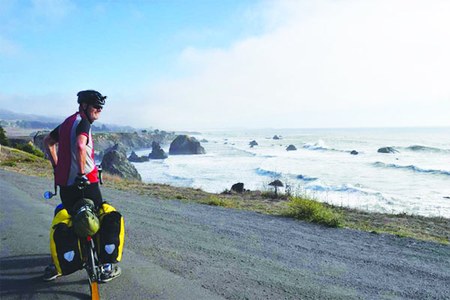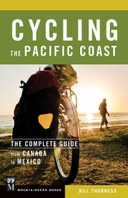
Bill Thorness's new book, Cycling the Pacific Coast: The Complete Guide from Canada to Mexico, is an epic accomplishment both for the effort it takes to research and write a nearly 2000-mile route, and because Bill's book replaces one of the longest running and most popular guidebooks in Mountaineers Books library. The old title, in its fourth edition, had a great run (er, ride) but needed a complete rewrite. Here we talk with Bill about the route.
How long does it take to ride the Pacific Coast route?
For a guidebook author? Two years! Well, okay, that was my research period, where I went down the coast in sections, then went back multiple times to selected areas. It’s a long process of discovering the best routes and stops, photographing, consulting locals and devising interesting side trips and city tours.
For a determined cyclist who’s done these types of trips before? About two months. You could do the entire route with no side trips or days off in 37 days, but why? I recommend that you bask in the adventure as well as the accomplishment. That means doing a bit of wandering, taking a day off when you come to a place that you really love, and enjoying those detours, side trips, city tours and alternate routes.
However, I realize that many people do not have a schedule that allows them to just hit the road for two months. So I devised the route in such a way that you can do sections of it. If you have a week, tackle one discreet segment; two weeks, make a longer trek.
What’s your favorite part of this ride?
Right now I have two favorite sections to recommend: the middle of the Oregon Coast and a stretch of road in northern California’s redwoods forest called Avenue of the Giants.
Overall, the Oregon Coast provides the best cycling experience, I think, which is why a favorite has to be there. You’ll find hiker-biker campgrounds spaced nicely about a day’s ride apart. There are fun, interesting small towns dotting the coast. And the road along these capes is stunning and challenging, so it’s a very satisfying ride.
But for sheer awe-inspiring cycling, the redwood forest can’t be beat. Being under the dense canopy of the giant trees in their cool, moist air on that quiet side road has a spiritual vibe.
What sort of shape do you have to be in to even think about doing this?
You certainly need a level of physical fitness to tackle long bike rides, but most of the people I meet on the route are like me: not athletes, just people who build the stamina to do the ride as we go along. You do get stronger as you go, and your body gets used to getting back on the bike day after day. That said, many people experience saddle sores or muscle cramps when they first start, unless they’ve been training for it.
It’s not a competition, so give yourself permission to take it slow and take days off if necessary. I know people who plan a rest day every third or fourth day, and on that night, they get a motel and sleep in a real bed. I met a delightful couple from England who must have been in their upper 70s. They pedaled slowly, with smiles on their faces, and said they do maybe 25 to 30 miles a day. That’s much less than my 40 to 65 miles, but it was still a pace that got them down the road.
Is it safe to ride solo?
There is a certain amount of risk in getting on your bike for any ride, so it would not be honest to say it’s completely safe. You have to be alert about traffic, and you need a quality bike that will not break down and strand you on an unsafe stretch of road.
It’s prudent to be alert to the possibility of theft. I always lock my bike when camping and keep all my valuables with me in my tent. One campground host advised me to lock my bicycle wheels as well as the frame, as cyclists had been getting their wheels stolen while they slept. I started carrying a cable lock to do that – but I also pedaled on and found another campground that night.
I’ve always felt pretty safe, and I’ve heard very few stories from other cyclists of encountering problems with personal safety. This is where having a traveling companion and an ounce of prevention are good steps.
What’s the one travel item you wouldn’t want to be without on a long ride?
Comfortable camp shoes, preferably ones that do double-duty as water shoes. Space is at a premium in my panniers, so my extra shoes have to be lightweight and pack down to a very slim profile. Generally, water sandals fit the bill.
HEar more from Bill
Bill will be giving a number of presentations around Seattle and Western Washington, including a book-launch party at Cascade Bike Club on Nov. 15. View upcoming events.
 Mountaineers Books
Mountaineers Books
